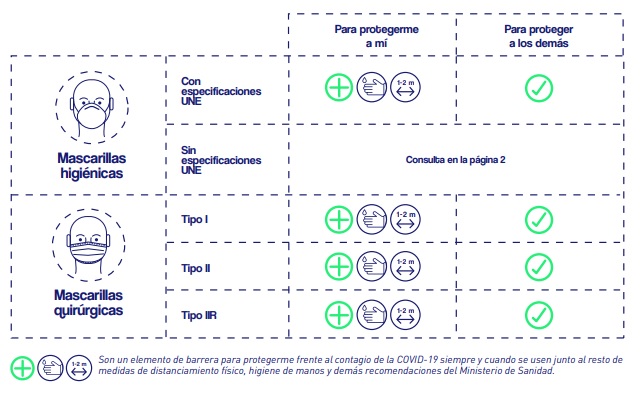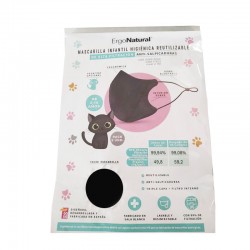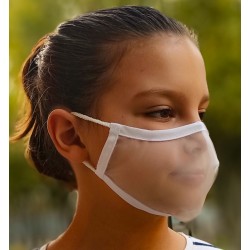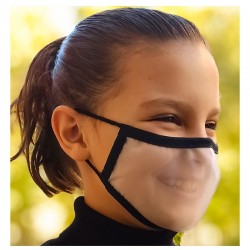Hygienic
- -16.74%
Transparent Reusable Mask Certified Eco-Repellent Color Black Size S - BEYFE
- -12.28%
Transparent Reusable Mask for Children (7-12 years) Gray Color 1 Mask - INCA
- -5.29%
Hygienic Masks
Hygienic Masks at Farma2Go
Hygienic Masks are designed to filter exhaled air. Its mission is to protect those around you, preventing the spread of viruses when sneezing, coughing or talking. They are useful for controlling infections in healthy populations, since if we all wear these masks, we are all protected, since they act as a barrier and stop possible droplets that are projected when sneezing or coughing. Even so, it is important to keep in mind that they are not personal protective equipment that follows Regulation EU/2016/425. This means that they protect other people more from possible contagion than oneself. Exactly the same thing happens as with surgery, but with less individual protection.
They are also known as barrier masks and are the most common and sweet potatoes. Intended for people without symptoms, you can find them non-reusable and reusable, the latter made with specific materials that allow them to be used more than once, always following the appropriate washing and disinfection steps. This type of masks can be made at home, following the basic standard and recommendations of health and scientific organizations.
Hygienic masks should not be considered a medical product, since they do not follow the same regulations and guidelines as these, nor personal protective equipment (PPE), in accordance with European regulations. When using this type of masks, we must be aware that we are not fully protected against possible infections nor are we exempt from being able to infect other people, so it is very important to complement their use with the rest of the preventive measures, both hygienic and like social distancing.
How do you put on a mask?
- Avoid touching the inside of the mask.
- Adjust the elastic band around your ears until you are in a comfortable position.
- Adjust the external face of the mask to the structure of the face until it is well deployed and sealed.
- Adjust the nose clip with both hands until it fits firmly on your nose.
- Change the mask if it is wet, damaged or if you have breathing difficulties.
The effectiveness of protection will depend largely on proper handling and use.

It is recommended that adults supervise the placement, use and removal of the mask in children.
Homemade Hygienic Masks
Although it is difficult for a homemade hygienic mask to guarantee the same safety as one of those you can purchase at Farma2Go, endorsed by a company that has carried out trials and tests, it is possible to make one of these masks by hand. When making hygienic masks at home, some important issues must be taken into account, such as that they must cover the nose, mouth and chin, they must consist of filtering material, they must ensure a proper fit with the face so that there are no leaks and they must have adjustment elastics or straps to tie. The material with which they must be made are folded layers of sealed or heat-sealed TNT, following the steps of cutting the flat pattern (done by hand or with machines), folding, sewing and fastening the hook on the ears, elastic or sewn material.
Approved Hygienic Masks
Reusable hygienic masks can be purchased in multiple stores, pharmacies, online stores, etc. However, you have to know how to differentiate between masks that comply with the UNE 0065:2020 regulation, those that do not comply with this regulation but do comply with other specifications and, finally, masks without specifications. At Farma2Go we recommend that you always use and purchase the first ones, which are those that are authentically approved, after being tested in laboratories and that present scientific evidence of their operation as a method of protection and prevention.
The UNE 0065:2020 regulation is developed by the Spanish Standardization Association to approve this product and ensure that all products that undergo this approval are safe and provide correct protection, without hidden failures or unforeseen effects. The purchase of this type of hygienic masks thus guarantees that these masks, in their preparation and manufacturing, have met a series of requirements in terms of design, manufacturing materials and use, among other issues. It is the only way to be sure that we are buying safe material.
This does not mean that those with other specifications are not safe, in fact, they could have a similar operation, but they have not been tested following the protocols established in Spain and we cannot be scientifically certain that their effectiveness is adequate. . Likewise, there are other types of reusable hygienic masks that have undergone clinical trials and bacterial filtration and breathability tests, but that have not met the quality standards required by UNE regulations. Still, this does not mean that they are totally useless, since in some cases, they can also offer good results in healthy people.
To exceed the quality indices required by UNE 0065:2020 regulations, hygienic masks must have at least a bacterial and particle filtration efficiency equal to or greater than 90% (since lower filtration does not ensure non-contagious diffusion). , as well as a breathability of less than 60 Pa/CM2, the purpose of which is to guarantee the correct functioning of our respiratory system without causing inconvenience.
Differences between Hygienic and Surgical Masks

To know the differences between them, you have to understand what each type of mask is for. The hygiene measures are a complement to the social distancing and hygiene measures recommended by the Spanish health authorities. They cover the orifices of the face that can exhale particles, covering the mouth, nose and chin. Provided with rubber bands that surround the head or are attached to the ears and composed of one or several layers of textile material. They can be reusable or single use.
For their part, surgical masks are those that we are used to seeing in healthcare and clinical environments, given that their objective is to prevent healthcare personnel and patients who are infected with a contagious virus from transmitting particles that carry these infectious agents. These masks filter exhaled air and protect those around them, preventing viral dispersion when performing everyday actions such as sneezing or coughing. Like hygienic ones, they are fixed to the face and adjusted using rubber bands or other mechanisms.
In addition, there are other types of masks, which are Personal Protective Equipment (PPE) , recommended especially for professionals who have to work in front of the public, since they create a barrier between the potential risk for the user. Thus, they filter the air both from inside to outside, and from outside to inside, protecting those around us and ourselves. Its purpose, in fact, is to filter the inhaled air, preventing the entry of contaminating particles into our body. Depending on their effectiveness, they can be FFP1, FFP2 or FFP3.
check_circle
check_circle




